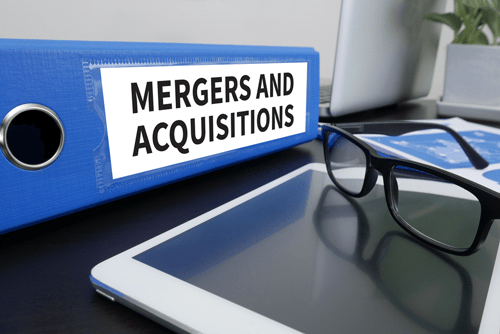- in Blog , Organisational Change , Research by David Wilkinson
- |
- 2 comments
Organisational mergers and acquisitions: The importance of culture change

An interesting paper has just been published looking at the role culture change plays in mergers and acquisitions.
The researchers estimate that approximately 30% of all mergers and acquisitions that fail to meet their objectives and outcomes, do so because of a clash of organisational cultures within the new merged organisation.
The paper proposes seven steps that can mitigate cultural problems during mergers and acquisitions that research evidence supports.
The problem of organisational culture in mergers and acquisitions
The authors define culture as “the long-standing, largely implicit shared values, beliefs, and assumptions that influence behaviour, attitudes, and meaning in a company or organization.”
Be impressively well-informed
Get your FREE organizational and people development research briefings, infographics, video research briefings, a free copy of The Oxford Review and more...
Part of the problem is that usually, those within the company or organisation are unlikely to see and determine the culture surrounding them, they just do it and are an active part of it every day. Culture is a largely hidden force that helps to determine meaning, assumptions and action within the organisation.
Additionally, organisational cultures are frequently fairly resilient to purposeful and non-organic change. Part of the reason for this resilience is that the culture is hidden and often unquestioned. Additionally culture plays a largely underpinning role in creating the thinking and behaviours of its agents and as such actually forms the rhetoric and understanding of the world inherent in the organisation.
Large company / small company difference
Mergers occur usually where both parties offer some form of intrinsic value to the other. One part of the merger provides or enhances a previously absent or comparatively weak capability or market penetration, for example for the purchasing or larger entity.
The success of the acquired company has usually been based on their way of doing things and their culture. An example is where a large, largely bureaucratic organisation, like Royal Mail, acquires a small fast moving and dynamic IT startup. Where the bureaucratic and slow moving parent organisation has its systems of work, that work for it, the fast moving IT company may well clash with the bureaucracy. This can fairly quickly stifle and even kill off the entrepreneurial IT company as people start to leave or projects take longer and longer to sign off due to the bureaucracy.
Here the parent company needs to both retain the staff in the smaller company that gave it value, but merge the two businesses without snuffing out the creativity and entrepreneurialism that actually made the smaller company a target for acquisition in the first place.
The 7 steps that can mitigate cultural problems during mergers and acquisitions
The paper, drawing on previous studies, identified seven processes that need to be put in place:
1. Make culture evaluation a major component of the change management.
2. Insist that the cultural work focuses on making the cultural evaluation tangible. Preferably there should be a steering body for this work which should be run and managed by senior human resources managers or organisational development practitioners. The paper states, “To drive home the importance of the issue, culture should be on the agenda of regularly scheduled (monthly/biweekly) Steering Committee meetings.”
3. Identify who “owns” the corporate culture and make them report to senior management. The paper states, “Culture owners should be required to discuss issues that are specific, well defined and supported by specific examples that can be tied to business results.”
4. Consider the strengths of both existing cultures not just the weaknesses. However this should not be like a mix CD with the “best of” tracks throughout the new organisation! Companies will not always fully mix well, as with Royal Mail’s acquisition of smaller IT start-ups. The paper states, “Where the cultures are different, there should be an assessment of whether the elements can be integrated.” It should be noted that some cultural areas can and should be kept apart.
5. Implement a decision making process that is not hampered by differences. Identify decision makers in each part of the organisation that is affected. Identify the styles of decision making and use this to assist decision making. Communicate expectations to those decision makers. Take an ‘adopt and go’ policy to decision making and emphasise the importance of speed in the process to all decision makers.
6. Build an employee brand that everyone in the new organisation can live with. The aim is for everyone to be just as proud to work for the new organisation as they were working for the component organisations prior to the merger.
7. Focus on flow. The paper says, “It is important to focus on the flow of work: how objects or information are passed from group to group or whether information is shared effectively. The interfaces should be designed, improved, or fixed so that they help create business value.”
Conclusions
In developing a structure in which behaviours are modified so the culture will change within the new organisation based on new workflows and optimum performance. The authors conclude, “By tying culture to value-creation and to identifying and changing specific behaviors when necessary, culture can become an effective tool for achieving post-merger integration objectives.”
References – members only
The difference between organisational culture and climate and why it matters
Be impressively well informed

Get the very latest research intelligence briefings, video research briefings, infographics and more sent direct to you as they are published
Be the most impressively well-informed and up-to-date person around...




1patriarchal
Drucker posited:”Culture eats strategy for breakfast” to illustrate the paramount importance of corporate culture. However, corporate culture is merely one albeit important element of a system that includes what Peter Scott Morgan called the unwritten rules or the unofficial culture, which is what people feel and that is developed bottom/up and that t may differ from the official culture preached top/down. Moreover, as I show in my new book Routledge 09/17, next to the corporate culture there are industry cultures and regional cultures. So, the leadership should look at the workings of these 4 cultures.
Companies that have diversified in totally different fields by acquisition have often failed. Exxon acquired start up and purposefully put them together under Exxon Office Systems, a brilliant idea that resulted in a liquidation and a massive write off that only Exxon could afford. Corning Glass diversified by acquiring Signetics, at the time an outstanding producer of integrated circuits. It struggled to understand that business environment and it sold Signetics to Philips. I do not see Signetics being mentioned today.